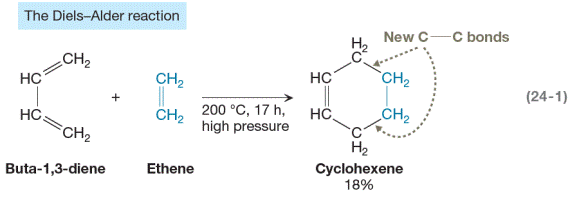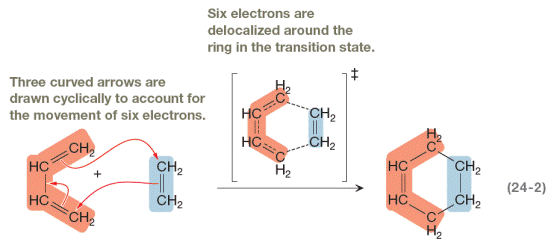
Concept explainers
Interpretation:
The elementary step in Equation 24-2 to depict a counterclockwise movement of the electrons is to be drawn. If this alternate way of drawing the curved arrows leads to the same product as shown in Equation 24-2 is to be explained.
Concept introduction:
Ethene reacts with buta-1, 3-diene, a conjugated diene, to form cyclohexene. This is the simplest example of what is called the Diels–Alder reaction. This reaction is so important in

Diels-Alder reactions can be carried out under mild conditions. The reaction is stereospecific and often regioselective, which can provide chemists substantial control over the products that are formed. The mechanism for the simplest possible Diels-Alder reaction (shown in Equation 24-1) is provided in Equation 24-2. This serves as the prototype for all other Diels-Alder reactions.

Want to see the full answer?
Check out a sample textbook solution
Chapter 24 Solutions
Organic Chemistry: Principles And Mechanisms: Study Guide/solutions Manual (second)
- Nonearrow_forward4. Draw and label all possible isomers for [M(py)3(DMSO)2(CI)] (py = pyridine, DMSO dimethylsulfoxide).arrow_forwardThe emission data in cps displayed in Table 1 is reported to two decimal places by the chemist. However, the instrument output is shown in Table 2. Table 2. Iron emission from ICP-AES Sample Blank Standard Emission, cps 579.503252562 9308340.13122 Unknown Sample 343.232365741 Did the chemist make the correct choice in how they choose to display the data up in Table 1? Choose the best explanation from the choices below. No. Since the instrument calculates 12 digits for all values, they should all be kept and not truncated. Doing so would eliminate significant information. No. Since the instrument calculates 5 decimal places for the standard, all of the values should be limited to the same number. The other decimal places are not significant for the blank and unknown sample. Yes. The way Saman made the standards was limited by the 250-mL volumetric flask. This glassware can report values to 2 decimal places, and this establishes our number of significant figures. Yes. Instrumental data…arrow_forward
- 7. Draw a curved arrow mechanism for the following reaction. HO cat. HCI OH in dioxane with 4A molecular sievesarrow_forwardTry: Convert the given 3D perspective structure to Newman projection about C2 - C3 bond (C2 carbon in the front). Also, show Newman projection of other possible staggered conformers and circle the most stable conformation. Use the template shown. F H3C Br Harrow_forwardNonearrow_forward
 Organic Chemistry: A Guided InquiryChemistryISBN:9780618974122Author:Andrei StraumanisPublisher:Cengage Learning
Organic Chemistry: A Guided InquiryChemistryISBN:9780618974122Author:Andrei StraumanisPublisher:Cengage Learning
